The Secretary General’s Annual Report 2021
On 31 March 2022, NATO Secretary General Jens Stoltenberg released his Annual Report for 2021.
It covers NATO's work and achievements throughout the year, including the Brussels Summit and the NATO 2030 decisions to make the Alliance stronger for the future, NATO cooperation with Ukraine, as well as the findings of NATO's annual Alliance-wide polling.
Below you will find short descriptions of – as well as direct links to – the elements of the annual report.
- Foreword
- NATO at a Glance
- For All Who Serve
- Preparing for the Future: NATO 2030
- Deterrence, Defence and Dialogue
- Investing in Defence
- Engaging with Citizens, Building Awareness
- Adapting the Alliance
- Promoting Peace
- Promoting Equality and Standing United
- Organisation
- Annexes
You can also download the full annual report.
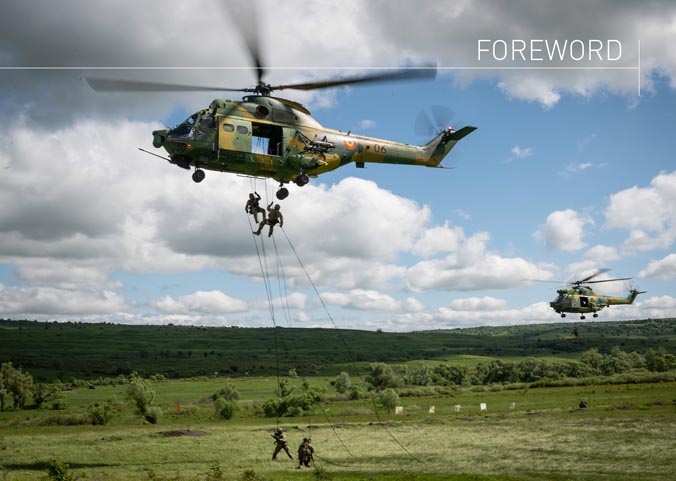
Photo: Romanian IAR 330 helicopters transport Special Forces troops during Exercise Steadfast Defender 2021. Cincu, Romania, May 2021.
Europe and North America United and Stronger Together in Turbulent Times
In a more dangerous and competitive world, NATO continues to do whatever is necessary to keep our people, nations and values safe.
Over the past year, Russia's aggressive rhetoric and actions have continued apace, culminating in the brutal and unprovoked invasion of Ukraine in late February 2022. President Putin has been clear that his objectives are not limited to Ukraine. He has demanded legally binding agreements to end further NATO enlargement, and to remove troops and infrastructure from NATO Allies that joined after 1997 — almost half of the Alliance. For the first time ever, in an agreement signed between Russia and China in early February 2022, Beijing has sided with Moscow in calling on NATO to stop admitting new members.
As this report goes to print, President Putin's war in Ukraine — enabled by Belarus — still rages, killing innocent civilians, destroying cities and infrastructure and causing millions to flee the country. In response, NATO Allies continue to step up support for Ukraine, impose economic costs on Russia, and bolster our deterrence and defence. In recent weeks, we have more than doubled our military presence in the eastern part of the Alliance, with more troops, aircraft and ships, to protect and defend every inch of Allied territory.
We have entered a new era in global security, where authoritarian powers, like Russia and China, are openly contesting core principles for our security, and seeking to re-write the entire international order on which our peace and prosperity depend. Moscow is using force to pursue its objectives. At the same time, other challenges to our security have not gone away, including terrorism, nuclear proliferation, cyber attacks, disruptive technologies and climate change.
Faced with this new reality, Europe and North America must continue to stand united and work closely together in a strong NATO. This is exactly what we are doing. At our Brussels Summit in June 2021, we agreed an ambitious and forward-looking NATO 2030 agenda. In this report, you will read about the concrete actions NATO has taken to adapt our Alliance politically and militarily to an ever-changing world.
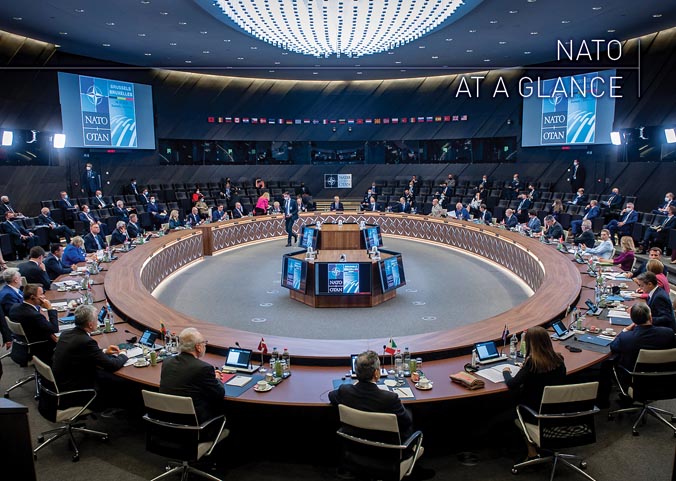
Photo: Meeting of the North Atlantic Council at the level of heads of state and government during the 2021 Brussels Summit. Brussels, Belgium, June 2021.
NATO at a Glance
Together, NATO Allies represent one billion people and roughly half of the world's economic and military might.
Why Was NATO Founded?
The North Atlantic Treaty Organization was founded in 1949 in the aftermath of the Second World War. Its essential purpose is to safeguard the freedom and security of all its members by political and military means. The principle of collective defence is at the very heart of NATO's founding document — the North Atlantic Treaty. This principle, enshrined in Article 5 of the Treaty, binds NATO Allies together, committing them to protect each other against attack. NATO strives to secure a lasting peace in Europe, based on common values of democracy, individual liberty and the rule of law.
How Many Member States Are There?
The Alliance started with 12 founding members: Belgium, Canada, Denmark, France, Iceland, Italy, Luxembourg, the Netherlands, Norway, Portugal, the United Kingdom and the United States. The North Atlantic Treaty allows other European states to join the Alliance, as long as all existing Allies agree. Any prospective member must share NATO's core values and have the capacity and willingness to contribute to security in the Euro-Atlantic area. Over the decades, the following 18 countries have joined NATO: Greece and Turkey (1952), Germany (1955), Spain (1982), the Czech Republic, Hungary and Poland (1999), Bulgaria, Estonia, Latvia, Lithuania, Romania, Slovakia, and Slovenia (2004), Albania and Croatia (2009), Montenegro (2017) and North Macedonia (2020). All 30 NATO Allies are stronger and safer together than they would be alone.
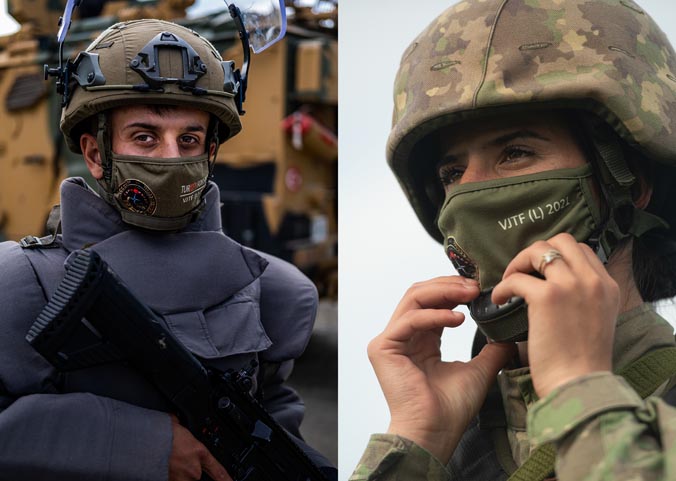
Photo: Turkish (left) and Romanian (right) soldiers. Romania, May 2021.
For All Who Serve
Thank you!
Thank you to the tens of thousands who served in 2021 from across Europe and North America in NATO military commands, exercises, missions and operations. Your service and sacrifice as soldiers, sailors, air force members and marines have helped keep the Alliance's one billion people safe throughout this complex year. You are the strong backbone that supports NATO's solidarity and our enduring values: democracy, individual liberty and the rule of law.
For those who served in Afghanistan, an additional word of thanks is in order. Over the past 20 years, no terrorist attacks from Afghanistan have harmed our people or countries. We owe this to you. And we pay special tribute to all those who made the ultimate sacrifice for our freedom.
In these uncertain times, we are reassured to know that you, the dedicated members of our armed forces, stand shoulder-to-shoulder to keep our nations safe.
Once again, thank you.
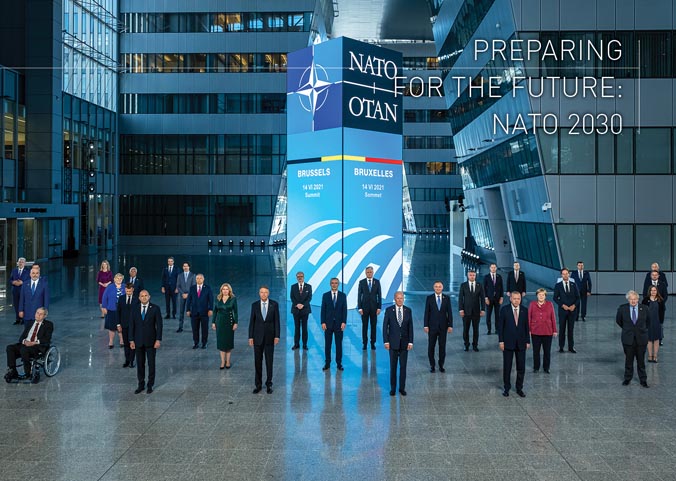
Photo: Official portrait of Allied Leaders during the 2021 Brussels Summit. Brussels, Belgium, June 2021.
Preparing for the Future: NATO 2030
NATO 2030 is an ambitious initiative, led by Secretary General Jens Stoltenberg, to make sure NATO remains ready, strong and united for a new era of increased global competition.
Throughout 2020 and 2021, the Secretary General consulted widely with Allies on how to make NATO even stronger and better prepared for the future. He also received valuable input from an independent group of experts1. In addition, the Secretary General engaged with civil society, young people, parliamentarians and the private sector to gather ideas that ultimately helped shape the NATO 2030 agenda.
NATO Allies endorsed this agenda at the Brussels Summit on 14 June 2021. It consists of eight key proposals.
- Enhancing Political Dialogue and Consultations
- Strengthening Deterrence and Defence
- Improving Resilience
- Preserving NATO’s Technological Edge
- Upholding the Rules-Based International Order
- Boosting Training and Capacity-Building
- Combatting and Adapting to Climate Change
- Toward NATO’s Next Strategic Concept in 2022
- The group was co-chaired by Thomas de Maizière (Germany) and A. Wess Mitchell (United States), and consisted of John Bew (United Kingdom), Greta Bossenmaier (Canada), Anja Dalgaard-Nielsen (Denmark), Marta Dassù (Italy), Anna Fotyga (Poland), Tacan Ildem (Turkey), Hubert Védrine (France), and Herna Verhagen (the Netherlands). The group submitted its report “NATO 2030: United for a New Era” to the Secretary General in November 2020.
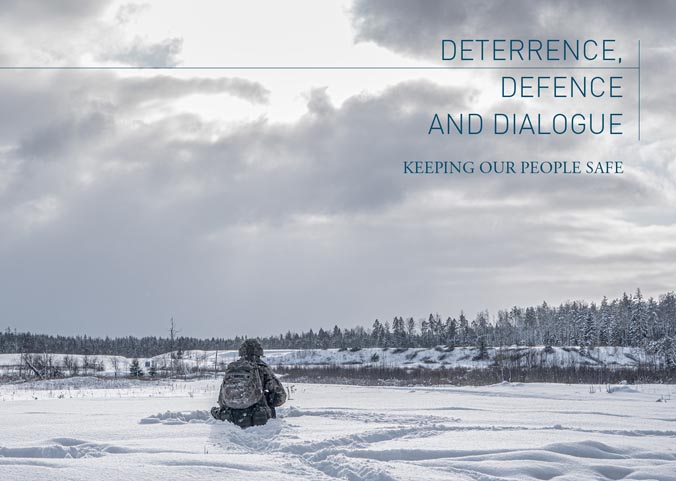
Photo: UK soldier, based with NATO’s enhanced Forward Presence Battlegroup in Estonia, during a cold weather training exercise. Estonia, February 2021.
Deterrence, Defence and Dialogue
NATO faces the most complex security environment since the end of the Cold War. In response, the Alliance has engaged in its biggest adaptation in a generation — increasing investments, modernising capabilities and investing in higher force readiness.
In 2021, Allies took further steps to ensure that the right forces are in the right place at the right time, including by continuing to invest in readiness and in the Alliance's rapid response capability. NATO has further implemented its Readiness Initiative, agreed in 2018. Designed to strengthen the culture of readiness within the Alliance and help provide forces within 30 days or less, the initiative also helps ensure that the Alliance is able to respond on short notice and quickly reinforce national forces on land, in the air and at sea — be it for crisis intervention or high-intensity warfighting. At the Brussels Summit in June 2021, Allies also agreed to further strengthen and modernise the NATO Force Structure — encompassing the national and multinational forces available to NATO — to meet current and future deterrence and defence needs.
Read the chapter "Deterrence, Defence and Dialogue" in the Annual Report (PDF)
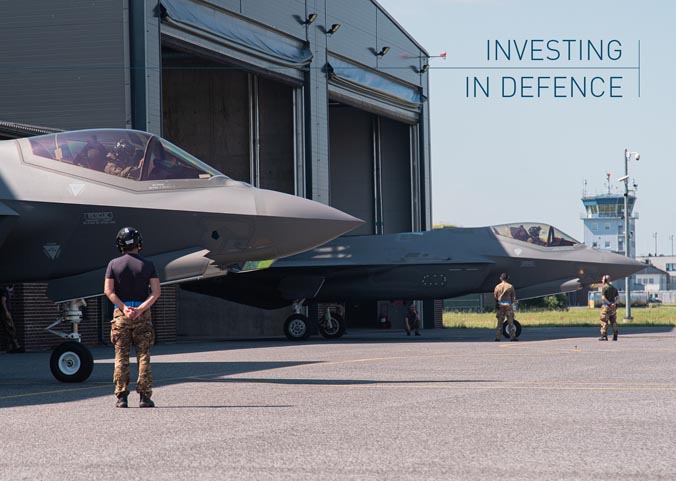
Photo: Two Italian F-35 Lightning II fighters leave their hangar at Ämari Air Base in Estonia as part of NATO Air Policing exercise Ramstein Alloy. Ämari, Estonia, July 2021.
Investing in Defence
The threats and security challenges that led to the adoption of the Defence Investment Pledge in 2014 have not subsided. Indeed, they have multiplied and intensified. By investing in defence, NATO Allies continue to develop, acquire and maintain the forces and capabilities required to ensure the Alliance's security in this challenging and unpredictable environment.
For seven consecutive years, European Allies and Canada have increased defence spending. From 2020 to 2021, defence spending increased by 3.1% in real terms. In total, over the last seven years, this increase added USD 270 billion for defence.
In 2021, eight Allies met the guideline of spending 2% of their GDP on defence, up from just three Allies in 2014. The United States accounted for 51% of the Allies' combined GDP and 69% of combined defence expenditure. Total NATO military spending in 2021 was estimated to exceed USD 1 trillion.
Read the chapter "Investing in Defence" in the Annual Report (PDF)
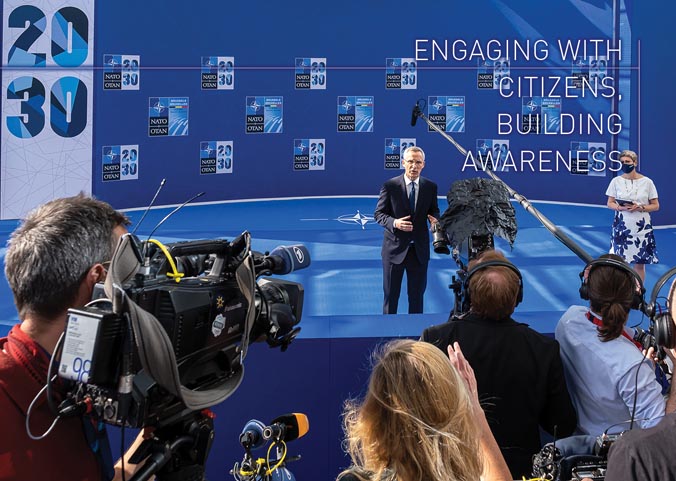
Photo: Doorstep statement by NATO Secretary General Jens Stoltenberg at the opening of the NATO Summit in Brussels, Belgium. June 2021.
Engaging with Citizens, Building Awareness
Citizens who understand and support NATO's mission are vital to the Alliance's continued success. Keeping citizens in Allied countries and around the world informed is, therefore, a large part of the Alliance's vigorous communications and public diplomacy engagement.
NATO is continually reaching out to audiences — both existing and new — with information and news about what NATO is, what it is doing and why it is important. In addition, given today's information environment, NATO works hard to counter hostile information — including disinformation — with fact-based, credible public communications.
Read the chapter "Engaging with Citizens, Building Awareness" in the Annual Report (PDF)
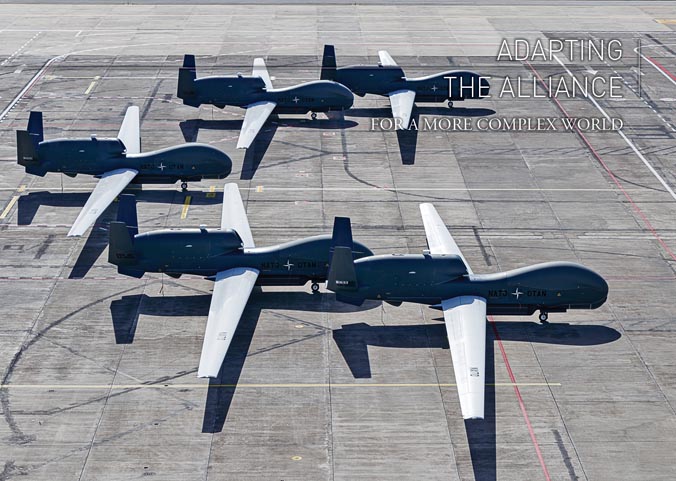
Photo: The full complement of five NATO Alliance Ground Surveillance Phoenix RQ-4Ds on display, for which initial operational capability has been declared. Sigonella, Italy, February 2021.
Adapting the Alliance
Since its founding in 1949, NATO has been able to adapt to changing security challenges. In 2021, as the security environment grew more complex, NATO modernised its military structures and capabilities, accelerated innovation and stepped up efforts to address the impact of climate change on security.
Read the chapter "Adapting the Alliance" in the Annual Report (PDF)
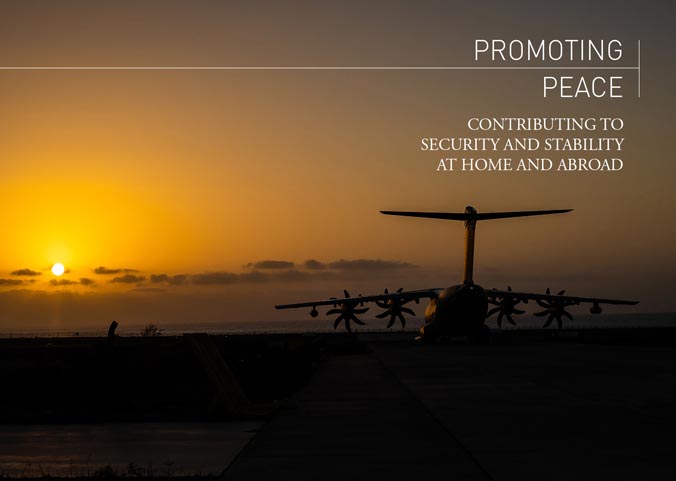
Photo: A Spanish Air Force A400M multirole tanker taxis into the sunrise during Exercise European Air Refuelling Training 2021. Held over Spain’s Canary Islands, this exercise gave Allies a chance to practise aerial refuelling while supporting the Spanish-led fighter exercise Ocean Sky 2021. Lanzarote, Spain, October 2021.
Promoting Peace
To keep its people safe and protect its fundamental values — democracy, individual liberty and the rule of law — NATO engages in operations and missions beyond its borders, and cooperates with a range of partner organisations and countries near and far.
Working closely together, NATO and its partners can better uphold the rules-based international order, defend common values and interests and tackle global challenges, including terrorism.
Read the chapter "Promoting Peace" in the Annual Report (PDF)
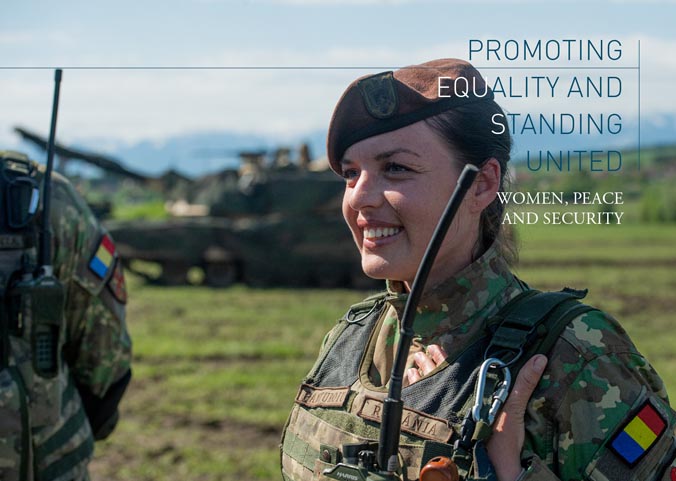
Photo: An officer from Romania’s 26th Battalion rehearsing for Joint Allied Power Demonstration Day, part of Exercise Steadfast Defender 2021. Cincu Romania, May 2021.
Promoting Equality and Standing United
In 2021, NATO refined its focus on Women, Peace and Security, and laid a strong foundation for continued progress to advance gender equality and improve Alliance effectiveness. Meaningful progress has been made in adapting the way NATO thinks and acts since the adoption of its first policy on Women, Peace and Security in 2007, which framed how NATO would contribute to the implementation of UN Security Council Resolution 1325. This and subsequent UN resolutions on Women, Peace and Security have informed NATO's policies ever since.
The current policy, adopted in 2018, is built on three pillars: integration, inclusiveness and integrity. NATO recognises the disproportionate impact of conflict on women and the importance of their contributions to discussions and decisions around peace and security. NATO's approach is characterised by questioning assumptions about the security status quo and applying a gender lens to all that NATO does in the pursuit of equitable peace and stability.
Read the chapter "Promoting Equality and Standing United" in the Annual Report (PDF)
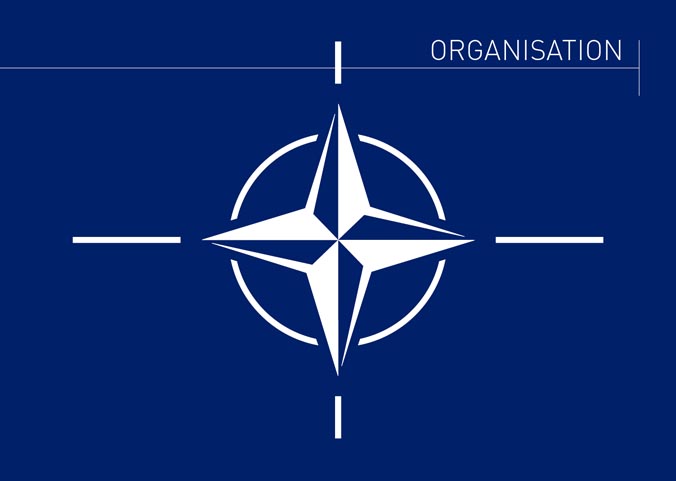
NATO Headquarters in Brussels houses the Alliance's International Staff and International Military Staff, along with 30 Allied delegations and military representations, 18 partner missions and staff from several NATO agencies. It is the central forum for the discussions and consultations that shape NATO policy and practice.

Kosovo Force (KFOR)
The NATO-led KFOR mission is to contribute to maintaining a safe and secure environment and freedom of movement for all communities in Kosovo, as mandated by the United Nations Security Council Resolution 1244 of 1999. In carrying out its activities, NATO cooperates with and assists the United Nations, the European Union and other international actors, as appropriate, to support the development of a stable and peaceful Kosovo. KFOR also supports the development of professional, democratic and multi-ethnic security structures in Kosovo.
Read the annex"Kosovo Force (KFOR)" in the Annual Report (PDF)
Defence Expenditure of NATO Countries (2013 – 2020)
NATO collects defence expenditure data from Allies and publishes it on a regular basis. Each Ally's Ministry of Defence reports current and estimated future defence expenditure according to an agreed definition. The amounts represent payments by a national government that have been or will be made during the course of the fiscal year to meet the needs of its armed forces, those of Allies or of the Alliance. In the figures and tables that follow, NATO also uses economic and demographic information available from the Directorate-General for Economic and Financial Affairs of the European Commission and the Organisation for Economic Co operation and Development.
Read the annex "Defence Expenditure of NATO Countries (2013 – 2019)" in the Annual Report (PDF)
